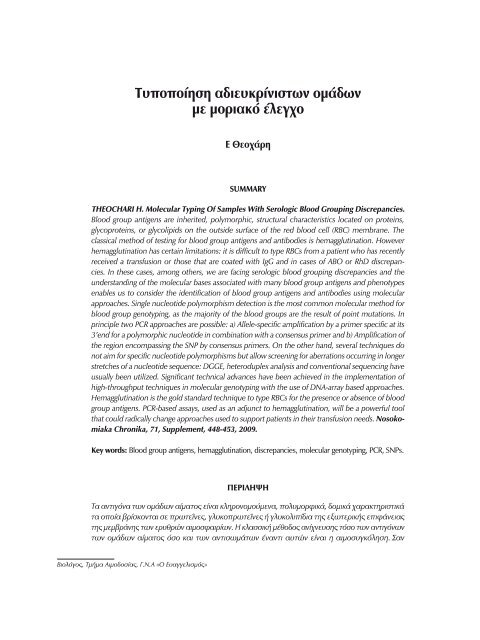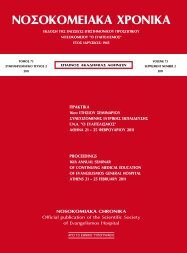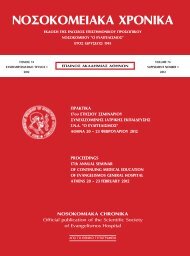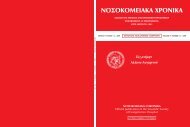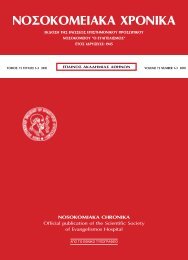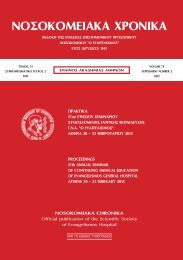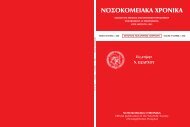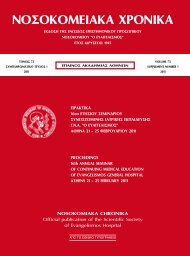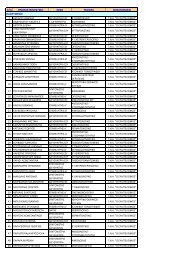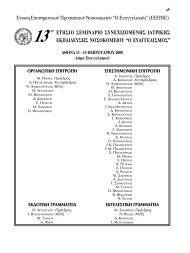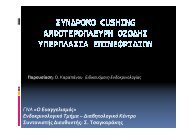åêðáéäåõóçó γ.ν.α.
åêðáéäåõóçó γ.ν.α.
åêðáéäåõóçó γ.ν.α.
Create successful ePaper yourself
Turn your PDF publications into a flip-book with our unique Google optimized e-Paper software.
448<br />
Τυποποίηση αδιευκρίνιστων ομάδων<br />
με μοριακό έλεγχο<br />
Ε Θεοχάρη<br />
SUMMARY<br />
Theochari H. Molecular Typing Of Samples With Serologic Blood Grouping Discrepancies.<br />
Blood group antigens are inherited, polymorphic, structural characteristics located on proteins,<br />
glycoproteins, or glycolipids on the outside surface of the red blood cell (RBC) membrane. The<br />
classical method of testing for blood group antigens and antibodies is hemagglutination. However<br />
hemagglutination has certain limitations: it is difficult to type RBCs from a patient who has recently<br />
received a transfusion or those that are coated with IgG and in cases of ABO or RhD discrepancies.<br />
In these cases, among others, we are facing serologic blood grouping discrepancies and the<br />
understanding of the molecular bases associated with many blood group antigens and phenotypes<br />
enables us to consider the identification of blood group antigens and antibodies using molecular<br />
approaches. Single nucleotide polymorphism detection is the most common molecular method for<br />
blood group genotyping, as the majority of the blood groups are the result of point mutations. In<br />
principle two PCR approaches are possible: a) Allele-specific amplification by a primer specific at its<br />
3’end for a polymorphic nucleotide in combination with a consensus primer and b) Amplification of<br />
the region encompassing the SNP by consensus primers. On the other hand, several techniques do<br />
not aim for specific nucleotide polymorphisms but allow screening for aberrations occurring in longer<br />
stretches of a nucleotide sequence: DGGE, heteroduplex analysis and conventional sequencing have<br />
usually been utilized. Significant technical advances have been achieved in the implementation of<br />
high-throughput techniques in molecular genotyping with the use of DNA-array based approaches.<br />
Hemagglutination is the gold standard technique to type RBCs for the presence or absence of blood<br />
group antigens. PCR-based assays, used as an adjunct to hemagglutination, will be a powerful tool<br />
that could radically change approaches used to support patients in their transfusion needs. Nosokomiaka<br />
Chronika, 71, Supplement, 448-453, 2009.<br />
xxxxxxxxx<br />
xxxxxxxxxxxx<br />
xxxxxxxxxxxx<br />
Key words: Βlood group antigens, hemagglutination, discrepancies, molecular genotyping, PCR, SNPs.<br />
ΠΕΡΙΛΗΨΗ<br />
Τα αντιγόνα των ομάδων αίματος είναι κληρονομούμενα, πολυμορφικά, δομικά χαρακτηριστικά<br />
τα οποία βρίσκονται σε πρωτεΐνες, γλυκοπρωτεΐνες ή γλυκολιπίδια της εξωτερικής επιφάνειας<br />
της μεμβράνης των ερυθρών αιμοσφαιρίων. Η κλασσική μέθοδος ανίχνευσης τόσο των αντιγόνων<br />
των ομάδων αίματος όσο και των αντισωμάτων έναντι αυτών είναι η αιμοσυγκόληση. Σαν<br />
Βιολόγος, Τμήμα Αιμοδοσίας, Γ.Ν.Α «Ο Ευαγγελισμός»


